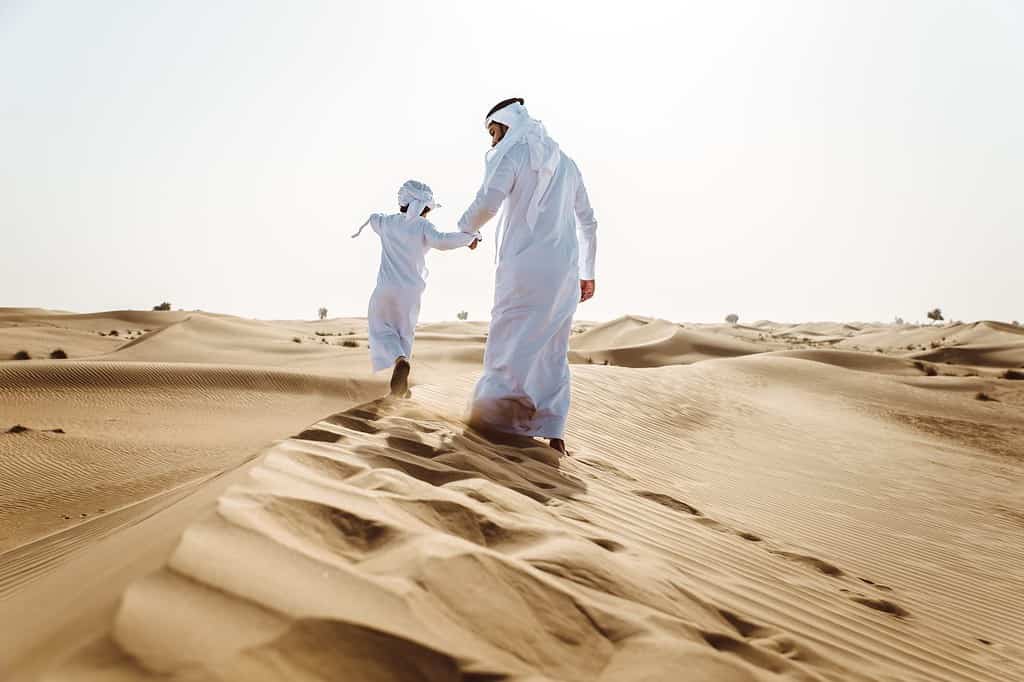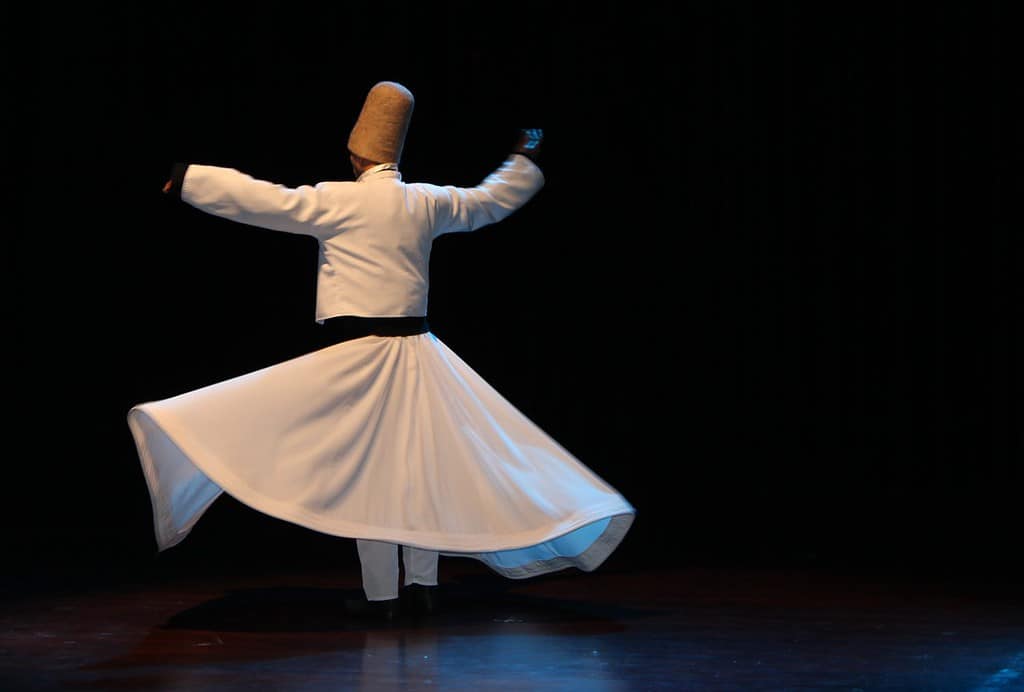Islam, along with Judaism and Christianity, is one of the three major monotheistic faiths of the world. With 1.8 billion Muslims worldwide, there’s a good chance you will interact with many followers of Islam during your lifetime. Understanding some basic aspects of Islam allows us to speak intelligently about this religion. One area of confusion for many people is the difference between an “Arab” country and an “Islamic” country. This important distinction is key to understanding the political dynamics in the Middle East today.
Ethnicities in the Middle East

Arabs are the largest ethnic group in the Middle East, but 85% of Muslims are not Arabs.
©oneinchpunch/Shutterstock.com
Islam started in the Arabian Peninsula, which is also the ancestral homeland of the Arab ethnic group. The language they speak is Arabic. With over 475 million people spread over 22 different countries, Arabs are the largest ethnic group in the region. Most Arabs are Muslims, but most Muslims are not Arabs. Only 15% of the world’s Muslim population is ethnically Arab.
Arabs are not the only ethnic group living in the Middle East. In fact, there are dozens of others, each with its own customs and some with a separate language and even a different religion. Some of these groups number in the tens of millions, while others may have only a few thousand members. Examples include the Turks, who have their own language and country (Türkiye), and the Persians, who speak Farsi and live mainly in Iran. The Kurds are the largest ethnic minority in the region that does not have its own state. They live mainly in Iraq, Syria, Turkey, and Iran. Many of these ethnic groups are Islamic, but not all of them are. The Yazidis of Iraq, for example, are a non-Islamic ethnic minority.
Background of Islam

Muslims worldwide bow in the direction of the Ka’aba, the center of the annual pilgrimage to Mecca.
©Sigit Prasetio/Shutterstock.com
Islam started in the year 610 in what is today Saudi Arabia. A man named Muhammad went into seclusion to pray and came back reporting that an angel had given him a message to preach. The core of the message is the belief that there is just one God, and that Muhammad is his prophet. Other important requirements of the new faith were to pray five times a day, to give charity to the poor, to fast during daylight hours during the month of Ramadan, and to make a pilgrimage to Mecca at least once in a lifetime.
Muhammad and his followers faced strident opposition and engaged in fierce armed battles. However, over time, the new belief system prevailed and spread beyond the confines of the Arabian Peninsula. Eventually, Muslims became the majority in North Africa, the Middle East, Central and South Asia, and the Southeast Asian islands. Spain, southern Italy, and the Balkans are areas of Europe that were under Islamic rule at one time. In essence, the Arab people group converted to Islam, then brought a lot of other ethnic groups under their influence and converted many of them to Islam.
Arab in Culture, but Not Arab

People of non-Arab ethnic background became Muslims (followers of the Islamic faith).
©Prostock-studio/Shutterstock.com
The real point of confusion in the difference between “Arab” and “Islamic” is that Islam began with Arabs, and the Islamic scripture, the Qur’an, is written in Arabic. As Arabs spread the religion, they taught people to pray in Arabic and adopt many aspects of Arab culture. A fundamental belief in Islam is that the Qur’an is accurate only when it is read, studied, or recited in the original Arabic language. Translations are considered human “interpretations,” not the authoritative words of God.
Other ethnic groups like the Azerbaijanis or the Somalis became somewhat Arab in culture, but that didn’t change their ethnicity. Of course, no ethnic group can change ethnicity by adapting a language, religion, or other aspects of culture.
Why Does the Distinction Matter?

Whirling dervishes are a cultural expression of Islamic Turks that differs from practices of Arab Muslims.
©Duygu Silen/Shutterstock.com
The distinction between the terms “Arab” and “Islamic” is important. Here’s why:
They Describe Different Things
The terms describe different things. For example, the term “Arab” is like the term “British.” It describes an ethnic heritage. However, the term “Islamic” is like the term “Christian.” It describes a religious belief system.
They Limit or Expand the Scope of the Religion
Islam is one of the religions of the world that says its message is for everyone, not just for one ethnic group. Calling all Muslims “Arabs” gives the impression it is only for Arabs, and not meant for Danes, Zulus, Australians, or any other groups.
They Help Us Understand Cultural Variations
Sometimes people of the same belief system practice in very different ways. People brought practices from their own separate ethnic cultures into Islam.
They Help Us Understand Political Tensions
Many of the tensions between countries in the world today are based on ethnic heritage. Religious differences may or may not be part of those tensions. Realizing that different ethnic groups run Saudi Arabia (Arabs) and Iran (Persians) can help us understand why two strongly Islamic countries are also bitter competitors.
List of Arab and Islamic Countries
The table below lists the world’s Arab and Islamic-majority countries. There are 57 Islamic countries in the Organization of Islamic Cooperation; 22 of them are Arab countries in the League of Arab States. A country does not necessarily follow Islamic law just because it identifies as Islamic. These countries have different forms of government and apply Islamic law to various degrees, depending on the specific country.
| Country | Region | League of Arab States | Organization of Islamic Cooperation | |
|---|---|---|---|---|
| 1 | Afghanistan | Central Asia | No | Yes |
| 2 | Albania | Europe | No | Yes |
| 3 | Algeria | Africa | Yes | Yes |
| 4 | Azerbaijan | Middle East | No | Yes |
| 5 | Bahrain | Middle East | Yes | Yes |
| 6 | Bangladesh | South Asia | No | Yes |
| 7 | Benin | Africa | No | Yes |
| 8 | Brunei | Southeast Asia | No | Yes |
| 9 | Burkina Faso | Africa | No | Yes |
| 10 | Cameroon | Africa | No | Yes |
| 11 | Chad | Africa | No | Yes |
| 12 | Comoros | Africa | Yes | Yes |
| 13 | Cote D’Ivoire | Africa | No | Yes |
| 14 | Djibouti | Africa | Yes | Yes |
| 15 | Egypt | Africa | Yes | Yes |
| 16 | Gabon | Africa | No | Yes |
| 17 | Gambia | Africa | No | Yes |
| 18 | Guinea | Africa | Yes | |
| 19 | Guinea-Bissau | Africa | Yes | |
| 20 | Guyana | South America | Yes | |
| 21 | Indonesia | Southeast Asia | No | Yes |
| 22 | Iraq | Middle East | Yes | Yes |
| 23 | Iran | Middle East | Yes | |
| 24 | Jordan | Middle East | Yes | Yes |
| 25 | Kazakhstan | Central Asia | Yes | |
| 26 | Kuwait | Middle East | Yes | Yes |
| 27 | Kyrgyzstan | Central Asia | Yes | |
| 28 | Lebanon | Middle East | Yes | Yes |
| 29 | Libya | Africa | Yes | Yes |
| 30 | Malaysia | Southeast Asia | Yes | |
| 31 | Maldives | South Asia | Yes | |
| 32 | Mali | Africa | Yes | |
| 33 | Mauritania | Africa | Yes | Yes |
| 34 | Morocco | Africa | Yes | Yes |
| 35 | Mozambique | Africa | Yes | |
| 36 | Niger | Africa | Yes | |
| 37 | Nigeria | Africa | Yes | |
| 38 | Oman | Middle East | Yes | Yes |
| 39 | Pakistan | South Asia | Yes | |
| 40 | Palestine | Middle East | Yes | Yes |
| 41 | Qatar | Middle East | Yes | Yes |
| 42 | Saudi Arabia | Middle East | Yes | Yes |
| 43 | Senegal | Africa | Yes | |
| 44 | Sierra Leone | Africa | Yes | |
| 45 | Somalia | Africa | Yes | Yes |
| 46 | Sudan | Africa | Yes | Yes |
| 47 | Syria | Middle East | Yes | Yes |
| 48 | Surinam | South America | Yes | |
| 49 | Tajikistan | Central Asia | Yes | |
| 50 | Togo | Africa | Yes | |
| 51 | Tunisia | Africa | Yes | Yes |
| 52 | Türkiye | Middle East | Yes | |
| 53 | Turkmenistan | Central Asia | Yes | |
| 54 | Uganda | Africa | Yes | |
| 55 | United Arab Emirates | Middle East | Yes | Yes |
| 56 | Uzbekistan | Central Asia | Yes | |
| 57 | Yemen | Middle East | Yes | Yes |
The photo featured at the top of this post is © iStock.com/Pe3check
Thank you for reading! Have some feedback for us? Contact the AZ Animals editorial team.






